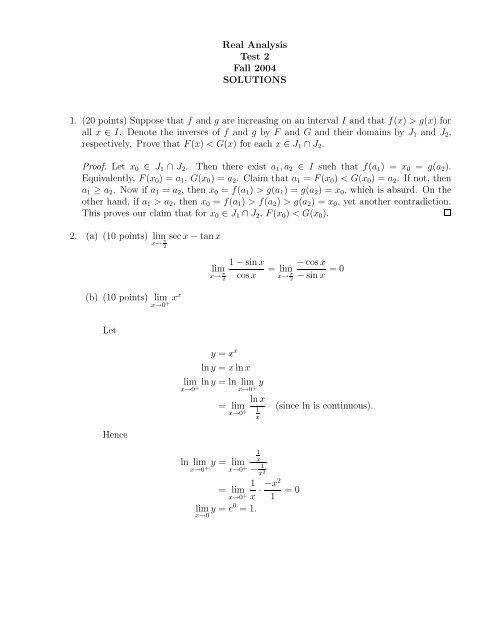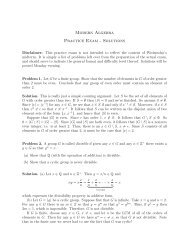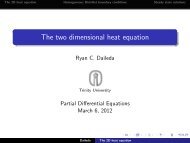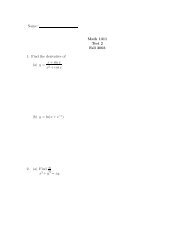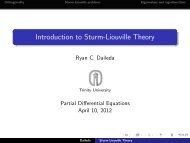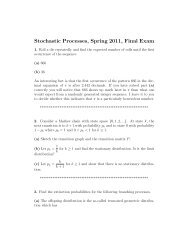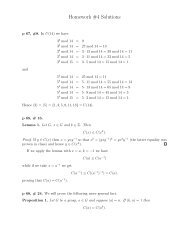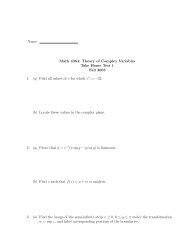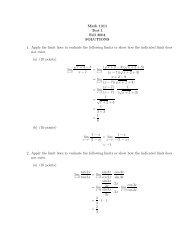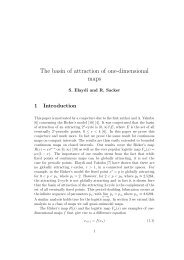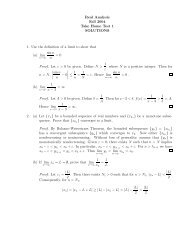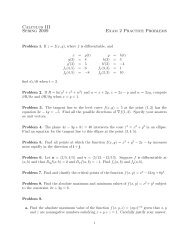Real Analysis Test 2 Fall 2004 SOLUTIONS 1. (20 points) Suppose ...
Real Analysis Test 2 Fall 2004 SOLUTIONS 1. (20 points) Suppose ...
Real Analysis Test 2 Fall 2004 SOLUTIONS 1. (20 points) Suppose ...
Create successful ePaper yourself
Turn your PDF publications into a flip-book with our unique Google optimized e-Paper software.
<strong>Real</strong> <strong>Analysis</strong><br />
<strong>Test</strong> 2<br />
<strong>Fall</strong> <strong><strong>20</strong>04</strong><br />
<strong>SOLUTIONS</strong><br />
<strong>1.</strong> (<strong>20</strong> <strong>points</strong>) <strong>Suppose</strong> that f and g are increasing on an interval I and that f(x) > g(x) for<br />
all x ∈ I. Denote the inverses of f and g by F and G and their domains by J 1 and J 2 ,<br />
respectively. Prove that F (x) < G(x) for each x ∈ J 1 ∩ J 2 .<br />
Proof. Let x 0 ∈ J 1 ∩ J 2 . Then there exist a 1 , a 2 ∈ I such that f(a 1 ) = x 0 = g(a 2 ).<br />
Equivalently, F (x 0 ) = a 1 , G(x 0 ) = a 2 . Claim that a 1 = F (x 0 ) < G(x 0 ) = a 2 . If not, then<br />
a 1 ≥ a 2 . Now if a 1 = a 2 , then x 0 = f(a 1 ) > g(a 1 ) = g(a 2 ) = x 0 , which is absurd. On the<br />
other hand, if a 1 > a 2 , then x 0 = f(a 1 ) > f(a 2 ) > g(a 2 ) = x 0 , yet another contradiction.<br />
This proves our claim that for x 0 ∈ J 1 ∩ J 2 , F (x 0 ) < G(x 0 ).<br />
2. (a) (10 <strong>points</strong>) lim sec x − tan x<br />
x→<br />
π<br />
2<br />
lim<br />
x→ π 2<br />
1 − sin x<br />
cos x<br />
− cos x<br />
= lim<br />
x→<br />
π<br />
2<br />
− sin x = 0<br />
(b) (10 <strong>points</strong>) lim<br />
x→0 + xx<br />
Let<br />
y = x x<br />
ln y = x ln x<br />
lim ln y = ln lim y<br />
x→0 + x→0 + ln x<br />
= lim<br />
x→0 + 1<br />
x<br />
(since ln is continuous).<br />
Hence<br />
ln lim<br />
x→0 + y = lim<br />
1<br />
x<br />
x→0 + − 1<br />
x 2<br />
1<br />
= lim<br />
x→0 + x · −x2<br />
1<br />
lim y =<br />
x→0 e0 = <strong>1.</strong><br />
= 0
3. (<strong>20</strong> <strong>points</strong>) <strong>Suppose</strong> that f and g are uniformly continuous on a subset S of R (not a<br />
closed interval). Prove that the function h = f − g is uniformly continuous.<br />
Proof. Since f, g are uniformly continuous on S ⊂ R, given ε > 0, there exists δ 1 , δ 2 > 0<br />
such that for x 1 , x 2 ∈ S with<br />
|x 1 − x 2 | < δ 1 ⇒ |f(x 1 ) − f(x 2 )| < ε 2<br />
(1)<br />
|x 1 − x 2 | < δ 2 ⇒ |g(x 1 ) − g(x 2 )| < ε 2 . (2)<br />
Let δ = min(δ 1 , δ 2 ). Then (1) and (2) hold if δ 1 , δ 2 are replaced by S. Now for |x 1 −x 2 | < δ,<br />
we have<br />
Thus h is uniformly continuous on S.<br />
4. Give examples of<br />
|h(x 1 ) − h(x 2 )| = |f(x 1 ) − g(x 1 ) − f(x 2 ) + g(x 2 )|<br />
= |f(x 1 ) − f(x 2 )| + |g(x 1 ) − g(x 2 )|<br />
< ε 2 + ε 2 = ε.<br />
(i) (5 <strong>points</strong>) A bounded sequence that is not Cauchy.<br />
Consider the sequence {(−1) n }, n = 1, 2, 3, . . . . It is bounded but not Cauchy.<br />
(ii) (5 <strong>points</strong>) A nested sequence {I n } of intervals such that ∞ ∩<br />
n=1<br />
= I n = ∅<br />
Let I n = ( 0, 1 n)<br />
, n = 1, 2, 3, . . . . Then In ⊃ I n+1 . But ∞ ∩<br />
n=1<br />
I n = ∅.<br />
(iii) (5 <strong>points</strong>) A continuous but not uniformly continuous function.<br />
f(x) = 1 x<br />
on (0, ∞) is continuous but not uniformly continuous.<br />
(iv) (5 <strong>points</strong>) A Cauchy sequence {x n } and a function f such that {f(x n )} is not Cauchy.<br />
{<br />
1<br />
x<br />
Define f(x) =<br />
, x > 0<br />
2, x = 0 on [0, ∞). Let x n = 1 . Then x n n → 0 as n → ∞,<br />
but f(x n ) = n → ∞ ≠ f(0) = 2.
5. Prove directly from the definition that the function f(x) = x 4 is uniformly continuous on<br />
the closed interval [0, 1]. Is f uniformly continuous on R?<br />
Proof. (a) We will show that f is continuous at each point x ∈ [0, 1]. Let x 0 ∈ [0, 1] and<br />
ε > 0 be given. Put δ = ε. Then for |x − x 4 0| < δ, we have<br />
|f(x) − f(x 0 )| = |x 4 − x 4 0 |<br />
= |x − x 0 ||x + x 0 ||x 2 + x 2 0 |<br />
< δ · 2 · 2 = ε.<br />
Hence f is continuous on x 0 . By Theorem 3.13, f is uniformly continuous on [0, 1].<br />
(b) Let x n = n, y n = n + 1 . Then |x n n − y n | = 1 → 0 as n → ∞. However,<br />
n |f(x n ) − f(y n )| =<br />
∣ n4 + 4 n3<br />
n + 6n2 n + 4 n 2 n + 1 ∣ ∣∣∣<br />
3 n − 4 n4 =<br />
∣ 4n2 + 6 + 4 n + 1 ∣ ∣∣∣<br />
→ ∞ as n → ∞.<br />
2 n 4<br />
Hence f is not uniformly continuous on R.


